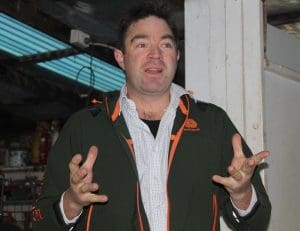
Peter Sandman. Picture – NSW Minerals Council.
A ‘MOTHER-IN-LAW’ approach by Australian Wool Innovation to not fight animal right activist criticism of the wool industry has received qualified acceptance from international risk communication specialist Peter Sandman.
But Dr Sandman believes that making a case that the way to sustain the wool industry’s social licence by shrugging off animal welfare controversies and selling lots of wool is “wrong-headed.”
However, the United States-based risk and outrage communications expert supported AWI corporate communications manager Marius Cuming’s advocacy of research on issues like mulesing pain relief and his assertion that every farmer in Australia should be an animal welfare activist.
“This is exactly right.”
Click here to get the latest Sheep Central story links sent to your email inbox.
Don’t fight your mother-in-law

AWI corporate communications manager Marius Cuming.
During a recent Australian Superfine Wool Growers Association farm tour, Mr Cuming likened the wool industry’s animal rights activist critics to mothers-in-law. Click here to read the original Sheep Central story.
“You will never, ever, ever, win a fight with your mother-in-law, and if you think you’ve won it, you’ve still lost it, haven’t you? Mr Cuming said.
He also said animal rights activists lose every time a woollen garment is sold, so selling products was “the most important thing to do” and having a profitable industry was a great way to keep a social licence strong.
Dr Sandman said companies and industries shouldn’t usually aim to win fights against their critics.
“They should aim to settle fights, calm fights, negotiate peace, and avoid recruiting new critics.
“While I don’t much like mother-in-law analogies, I accept Cuming’s point that when people are criticizing an industry, there is no such thing as “victory” – so in most cases a company or industry that sets out to defeat its critics will only make things worse.”
Dr Sandman said “two ways Marius Cuming is right”, included that companies and industries shouldn’t usually aim to win fights against their critics.
“They should aim to settle fights, calm fights, negotiate peace, and avoid recruiting new critics.
“While I don’t much like mother-in-law analogies, I accept Cuming’s point that when people are criticising an industry, there is no such thing as “victory” – so in most cases a company or industry that sets out to defeat its critics will only make things worse.”
Criticism usually doomed if industry fills a real need
Dr Sandman said the most extreme critics of a company or industry – those who want it out of business entirely – are usually doomed to fail if what the company or industry does meets a real need.
“It is both fair and effective to say so.
“When you’re under attack by an animal rights group that believes (for example) that sheep can’t give informed consent so all shearing is a kind of tyranny and oppression, it’s useful to distinguish such groups from animal welfare groups, which believes only that humans have a moral obligation to do what they can to minimize animals’ pain,” he said.
“In that sense, it’s helpful to point out to customers that their choice is stark: If they like woollens and intend to keep buying or using woollens, they have to be okay with not waiting till the sheep give their informed consent.”
Ignoring controversies is riskier
But Dr Sandman said making the case that the way to sustain the wool industry’s social licence to operate is shrug off animal welfare controversies and sell lots of wool was “wrong-headed.”
“For most purposes, people don’t “need” wool; they like it, but can live without it.
“The market for woollen garments is sufficiently discretionary that sales could go down markedly if large segments of the public came to see the industry as indifferent to serious public concerns,” Mr Sandman said.
“By contrast, the market for petroleum is comparatively immune to the commercial impact of public disapproval.
“So ignoring controversies – at least controversies with journalistic ‘legs’ – is far riskier than addressing them.”
Dr Sandman disagreed with Mr Cuming’s advice to not talk about mulesing, referring to the communications manager’s advice that talking about the practice would not lead to any more wool or wool products being sold.
“We’ve got to start looking at the donut and stop looking at the hole – the mother-in-law theory, everyone gets that,” Mr Cuming said.
To talk or not to talk — about mulesing
“What about the uninterested public?” Mr Sandman asked.
“When Cuming says that industry spokespeople shouldn’t talk about mulesing, he presumably has in mind an audience that isn’t paying attention to mulesing already.
“Addressing the issue genuinely does have two downsides: (a) cluing in the previously unaware portion of the public; and (b) reminding those who have heard about the controversy, but put it out of their minds,” he said.
“Addressing the issue also has two upsides: (a) Ameliorating the concern of the portion of the public that is already aware of mulesing and would like to think the industry is trying to minimize animal pain; and (b) “inoculating” the portion of the public that isn’t yet aware, so that when critics raise the issue they have a pre-existing sense that the industry is responding responsibly.”
“If the critics are impotent or incompetent and few if any Australians will ever hear about mulesing, the downsides of addressing the issue exceed its upsides, and Cuming is right to focus on selling wool rather than responding to critics,” he said.
“On the other hand, if the critics are already reaching a lot of Australians and are quite capable of mounting an effective campaign, then addressing the issue is wiser than avoiding it.”
Dr Sandman said it is “way, way wrong” to suggest that there’s no reason for the sheep and wool industry to address issues like mulesing – which is an animal welfare issue, not an animal rights issue.
“When animal rights groups raise animal welfare issues (or, generically, when extremist groups raise issues with moderate appeal), it’s fair game to note that the groups are reaching out beyond their core constituency, trying to seduce people into becoming animal rights supporters by raising legitimate animal welfare concerns.”
Dr Sandman said an industry could only make the point – ‘If mulesing were entirely abandoned by the Australian wool industry, animal rights activists would not slacken in their commitment to put a stop to sheep-raising, whether for food or fibre’ — if it was visibly taking animal welfare concerns to heart.
“The core question here is whether and where you dichotomize.
“Animal rights activists want to dichotomize in a way that isolates the sheep industry: sheep industry people who abuse animals versus the rest of us who are humane,” Dr Sandman said.
“(Mr) Cuming wants to dichotomize in a way that isolates the critics: extremists who think animals have the same rights as people versus the rest of us who are sane.”
Dr Sandman said settling the controversy requires a trichotomy:
- Animal rights extremists who think animals have the same rights as people.
- The rest of us who believe in animal welfare but not animal rights (which includes some but not all of the sheep industry).
- Sheep industry people who abuse animals.
Dr Sandman said the industry should therefore have two goals vis-à-vis the mulesing controversy and others like it:
- To convince (or coerce) more and more of the sheep industry to move from Group 3 to Group 2 – that is, to institute strong animal welfare policies throughout the industry.
- To convince the interested public that the industry takes the first goal – improving industry practices – seriously and is making good progress.
Low profile vs acknowledge and improve
Dr Sandman said generically, there are only four ways to respond to criticism:
- Keep a low profile – ignore the criticism and hope it won’t catch fire with too many people.
- Defend – rebut the criticism, making a case that your critics are wrong about you.
- Counterattack – criticize the critics, making a case that people should focus on their misdeeds, not yours.
- Acknowledge and improve – concede that at least some of what the critics are saying is true, and explain what you’re doing about it.
Dr Sandman said much of what Mr Cuming said suggests that he thinks the critics of mulesing have a good deal of power and impact.
“That’s why he has ruled out “defend” and “counterattack” – he thinks (rightly, I believe) that the industry can’t win a fight with its critics.
“Then he seems to conclude that the “low profile” option is the only one left,” he said.
“I don’t see why he is ruling out the “acknowledge and improve” option – the option most clearly supported by the facts as he describes them.”
Click here for Dr Peter Sandman’s full response to Sheep Central’s story on Marius Cuming’s social licence comments.

Well said Patrick Francis. “Acknowledge and improve” is the logical solution. You and Dr Sandman have articulated the reasons why very clearly.
Ah Patrick, you can wear the hair shirt fabric from those non-mulesing crossbreds from NZ as jocks and you can suffer in them. All those people not needing wool are currently paying plenty and needing it. At no point did people ever stop wearing wool. It all sold — at crap prices, but it still sold. Environmental integrity — wow, that sounds so expensive and exclusive, but why is everyone buying cheap Bangladesh clothing? Because apart from the hipsters, cheap is affordable. Everything else is gold-plating grease nipples.
Dr Peter Sandman’s “acknowledge and improve” option is highly applicable in Australia’s Merino sheep farming industry, because one sector of Merino sheep farmers are already taking this approach. They are the slowly increasing percentage of Merino sheep farmers who don’t mules their sheep because they have implemented genetic selection programs which minimise flystrike and or have sheep husbandry in place to minimise it. Once some farmers have demonstrated an animal welfare “improve” option by not mulesing their sheep, it becomes obvious to interested clothing retailers and members of the public that they have purchasing power to only buy Merino brands that use wool from non-mulesed sheep. Add in non-mulesed wool from New Zealand and South American Merino sheep and the strategy of ignoring mulesing criticism becomes an increasingly difficult marketing issue for a large component of Australia’s Merino wool production. As Sandman says “people don’t need wool,” so if Australian Merino sheep farmers want more consumers to pay the premium required for profitable production, then they should be prepared to meet their expectations for animal welfare and environmental integrity.
Groundhog day.